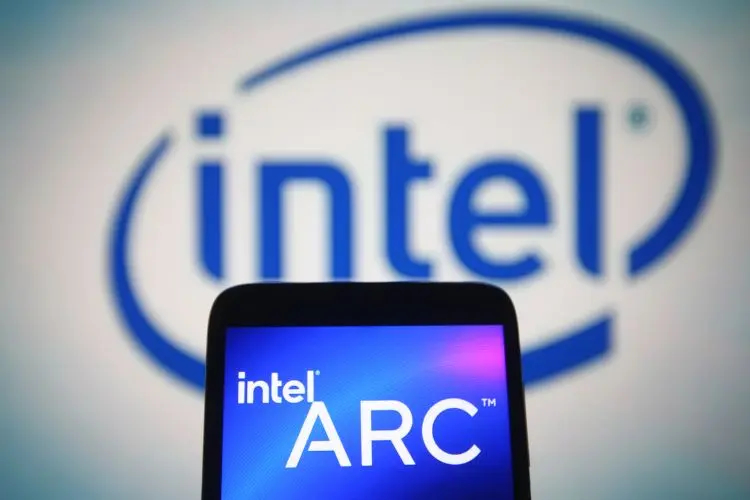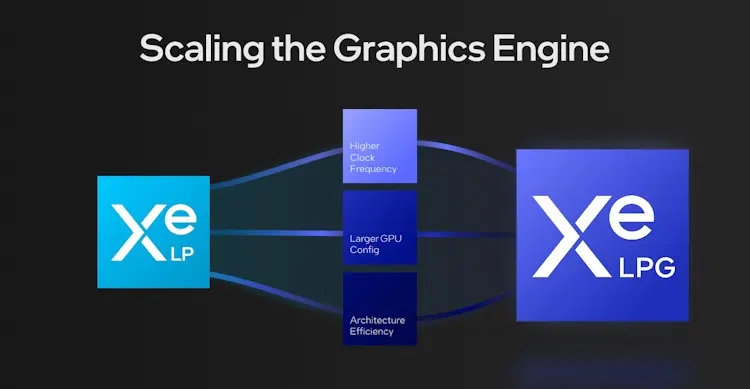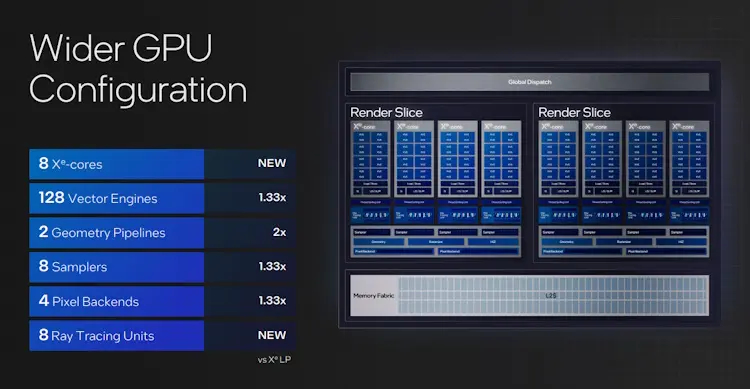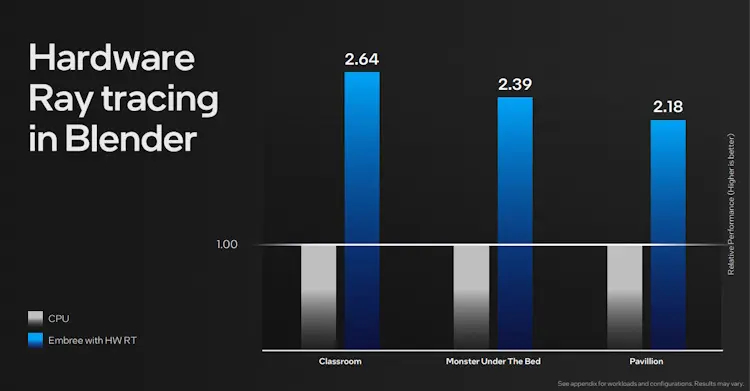
After months of anticipation and speculation, Intel has finally unveiled its 14th Gen Meteor Lake architecture. With a host of enhancements including improved power efficiency, AI capabilities, and a new E- and P-core microarchitecture, the chipset family brings several upgrades. Among the notable advancements is the integration of Intel Arc GPU support into the 14th Gen Meteor Lake chips, marking a significant milestone. Below, we delve into the details of Intel Arc in the 14th Gen.
The introduction of Intel Arc graphics brought forth a notable advantage: increased game frame rates. However, this capability was previously confined to dedicated GPU formats. With the advent of Meteor Lake, Intel Arc is now integrated with the chipset’s graphics, promising to enhance gaming experiences and other use cases. This integration is poised to deliver substantially improved frame rates across various applications.
Introducing the New Intel Xe LPG Architecture with Hardware Ray Tracing
The significant enhancement in graphical performance is attributed to the new Xe LPG architecture, which is integrated into the disaggregated architecture. LPG combines Intel’s previous Xe LP iteration with its HPG architecture, achieving a substantial improvement in performance. This advancement aligns with Intel’s objective of delivering twice the performance compared to the previous generation.
Moreover, the introduction of the Xe LPG architecture has introduced features previously unavailable in chipsets. These include support for DX 12 Ultimate, VRS (Variable Rate Shading), Hardware Ray Tracing, Sampler Feedback, and more. Intel asserts that all the features expected from high-end graphics are now available in Meteor Lake Chips. Notably, Intel Integrated graphics will incorporate Hardware Ray Tracing for the first time, marking a significant milestone.
Intel Xe LPG Implements Tri-Fold Approach
The new Intel Xe LPG engine, driving the innovation behind Arc, has been meticulously scaled to align with the company’s vision. This scaling effort adopts a three-pronged strategy, emphasizing higher clock frequencies, expanded GPU configurations, and enhanced architectural efficiency overall.

Intel’s 14th Gen Meteor Lake GPUs boast significant enhancements in frequency. These new units can operate at higher speeds across all voltage curves, achieving superior performance while consuming less energy for the same tasks.

The LPG architecture operates at higher clock speeds across all voltage levels and can run on lower voltages at specific frequencies. This capability is pivotal as it enables Intel Meteor Lake to achieve a remarkable 2x performance per watt. Additionally, this marks one of the first instances where the company has employed machine learning for timing closure, leading to additional power savings.
Intel Allocates More Silicon Area to Empower Arc
Increasing the power of a chip naturally necessitates more physical space. Intel disclosed that it employs a wider GPU configuration by utilizing additional silicon area to enhance the graphics engine. To quantify this, the new 14th-Gen Meteor Lake GPU tile is 30% larger. Additionally, a notable addition includes the inclusion of 8 Xe cores, which serve as computational blocks. Moreover, the chip features 128 Vector units, up from last year’s 96 units.

However, the standout features undoubtedly lie with the introduction of the new 8 Ray Tracing Units. As previously mentioned, these units bring Hardware Ray-Tracing support to Intel’s integrated graphics for the first time.
Moreover, Intel has placed a strong emphasis on architectural efficiency. The Xe Core is equipped with 16 256-bit vector engines and possesses 192KB of shared L1 Memory. This core can be configured as a Shared Local Memory (SLM) or function as a cache altogether. Intel has adopted a similar configuration style for Arc GPUs, aiming for synergy and software stability. The company believes this approach will provide software developers with a unified platform, facilitating the optimization of the new integrated graphics.
Meteor Lake Introduces DX 12 Ultimate & Ray Tracing Support
In addition to the aforementioned computational enhancements, one of the most significant announcements is the incorporation of DX 12 Ultimate and Ray Tracing support in Intel’s 14th Gen Meteor Lake. The inclusion of native DX 12 support will introduce features such as hardware Ray-Tracing, mesh shading, VRS Tier 2, and sampler feedback.

While Intel didn’t provide exact metrics, it did present some architectural tests comparing the new Xe LPG against LP in a few benchmarks. Notably, the Xe LPG demonstrated nearly 7x higher scores in the Depth test, with similar improvements observed in Vertex Processing, Triangle Draw Rate, and other metrics.
This performance was showcased at Intel Tech Tour Malaysia 2023, albeit behind closed doors. During the event, Intel displayed a gameplay video of Forza Horizon 4 running smoothly at 50-60 FPS using the onboard Intel Arc graphics. Although the game settings and machine configurations weren’t disclosed, the demo appeared exceptionally fluid with no visible stutters. This level of performance is expected to extend to other popular games as the chips gradually become available.
Ray Tracing Offers Diverse Applications Beyond Gaming
Ray Tracing makes its long-awaited debut in Intel’s Meteor Lake architecture. The company confirmed this development while discussing the use cases for hardware-accelerated Ray Tracing (HW RT). Intel showcased UL’s new Solar Bay benchmark, demonstrating that the new integrated graphics can handle real-time ray tracing. This, coupled with the array of improvements mentioned earlier, suggests that Meteor Lake will effectively leverage HW RT in future applications. However, the utilization of Intel’s new LPG extends beyond just Ray Tracing.

Creators receive a significant boost as Blender can now run on Intel’s 14th Gen Meteor Lake chips. This capability is attributed in part to Intel’s involvement in Embree, its RT library, which includes hardware ray tracing support. Given that Blender also utilizes Embree, users can now run the software directly from their chipsets. Intel showcased some hardware ray tracing Blender figures, revealing almost three times faster performance compared to traditional CPUs.
As a final use case, Intel believes there are numerous practical applications for Ray Tracing and is therefore conducting its own research to further explore these possibilities.
Intel Endurance Gaming Optimizes Battery Life for Gaming
While gaming on a laptop’s battery is typically discouraged, Intel acknowledges the demand for portable gaming. As a result, the integrated graphics of the new 14th Gen Meteor Lake will include Intel’s latest Intel Arc Control software. Serving as the control panel, this software enables users to adjust modes, including Intel’s Endurance Mode, a novel feature designed to dynamically manage power with graphics.
Users will have the option to select from three different modes, each of which caps frame rates accordingly while ensuring stable battery life. Intel demonstrated this capability by showcasing stats where Rocket League ran on just 1W of power, a remarkable achievement.
In addition to the graphical enhancements, Intel shed light on its disaggregated architecture, which encompasses the Xe Media Engine supporting up to 8k @ 60 10-bit HDR decode. Intel also discussed the new Xe Display Engine, boasting four pipes for multiple displays and comprehensive support for HDMI 2.1, DP 2.1 20G, up to 8k @ 60 HDR, QHD, FHD, and more.
With hardware ray tracing making its debut on integrated graphics for the first time, Intel’s 14th-Gen Meteor Lake lineup is poised to deliver an exceptional experience. Coupled with 2x performance per watt and enhanced power efficiency, the inclusion of Arc promises an exciting future.The true performance of Intel’s Arc graphical platform will only be unveiled with time.



